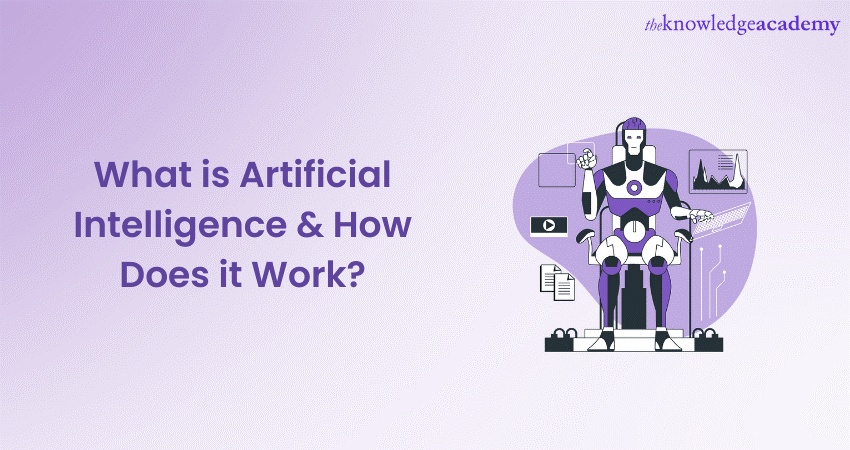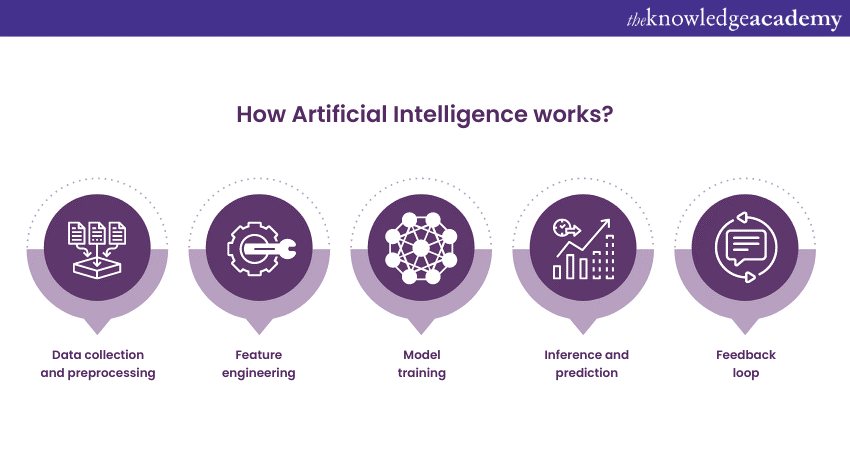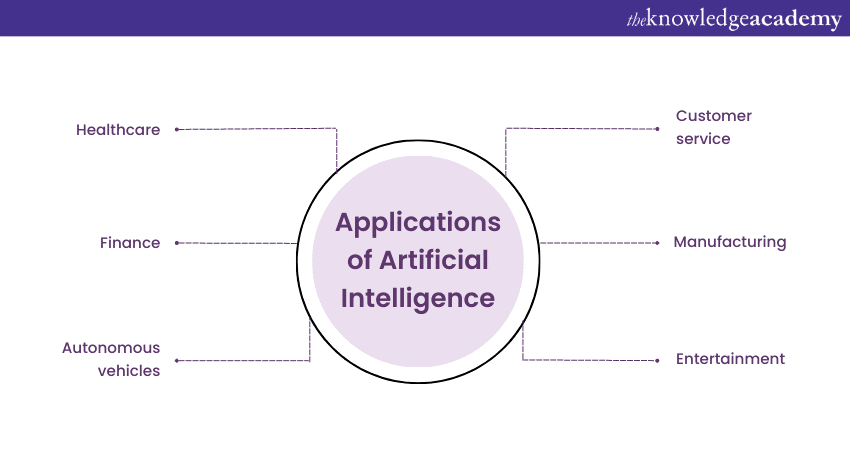We may not have the course you’re looking for. If you enquire or give us a call on 01344203999 and speak to our training experts, we may still be able to help with your training requirements.
Training Outcomes Within Your Budget!
We ensure quality, budget-alignment, and timely delivery by our expert instructors.

Artificial Intelligence (AI) is a field based on computer science that has not only captured the imagination of scientists and engineers but also sparked curiosity among people from all walks of life. The modern journey of AI began in the mid-20th century when the term was first coined at the Dartmouth conference in 1956.
As a branch of computer science, AI focuses on creating smart machines capable of performing tasks that typically require human intelligence. In this blog, we will understand What is Artificial Intelligence, its types, its key components, how AI works and more.
Table of Contents
1) What is Artificial Intelligence?
2) Types of Artificial Intelligence
3) Key components of Artificial Intelligence
4) How does Artificial Intelligence work?
5) Algorithms and techniques in AI
6) Applications of Artificial Intelligence
7) Conclusion
What is Artificial Intelligence?
AI encompasses a broad spectrum of capabilities, from solving complex problems to mimicking human-like thinking processes. It's about enabling machines to reason, perceive, and adapt in ways that make them not just powerful tools but also potential partners in various aspects of life. Artificial Intelligence is efficient in learning from experience, understanding natural language, recognising patterns, and making data-based decisions.
Unlock the potential of Artificial Intelligence with our Introduction to Artificial Intelligence Training.
Types of Artificial Intelligence
Artificial Intelligence (AI) comes in various forms, each with distinct characteristics and capabilities. These types of AI can be broadly categorised into Narrow or Weak AI, General or Strong AI, and the theoretical concept of Artificial Superintelligence. Let's explore these categories in simple terms with examples.
Narrow or Weak AI
Narrow AI or Weak AI is designed to perform specific tasks or solve particular problems. It excels within a limited domain and doesn't possess the broad intelligence and adaptability of a human. Think of Narrow AI as highly specialised tools.
Example: Virtual personal assistants like Siri or Alexa are Narrow AI. They can answer questions, set alarms, and play music but can't engage in general conversations or understand complex concepts beyond their programmed abilities.
General or Strong AI
General AI, also known as Strong AI, is the ultimate goal of AI research. It's a form of AI with human-like intelligence, capable of understanding, learning, and reasoning across various domains. General AI can adapt to new tasks and situations, much like humans.
Example: Chat GPT is an example of general AI, which is capable of performing a wide range of tasks, from playing multiple board games at a high level, like AlphaGo, to conversational AI that can engage in meaningful discussions on various topics.
Artificial Superintelligence
Artificial Superintelligence is a theoretical concept where AI surpasses human intelligence in every aspect. It would possess not only human-like intelligence but also an ability to learn and innovate at an unprecedented rate. This concept raises ethical and existential questions about the potential impact of superintelligent AI on society.
Example: Artificial Superintelligence remains a hypothetical concept, and no real-world example exists. However, science fiction often explores the potential consequences and scenarios associated with such advanced AI.
Key components of Artificial Intelligence
Artificial Intelligence relies on several key components that empower it to perform tasks that mimic human intelligence. These components include Machine Learning, Neural Networks, Natural Language Processing (NLP), Computer Vision, and Robotics. Let's explore each of these components:
Machine Learning
Machine Learning (ML) serves as the foundational principle of AI. It includes algorithms and statistical models that empower computer systems to enhance their proficiency in a particular task by drawing insights from data. Machines acquire knowledge from previous experiences and evolve to make more informed decisions as they progress forward.
Neural networks
Neural networks are components of Machine Learning models inspired by the human brain's structure. These networks consist of interconnected nodes, or "neurons," organised in layers. They are especially effective in handling complex data and are the foundation of Deep Learning, a subfield of AI.
Natural Language Processing
Natural Language Processing (NLP) is focused on enabling computers to understand and generate human language. It involves tasks like language translation, sentiment analysis, and chatbot interactions, making it essential for human-computer communication.
Computer vision
Computer Vision empowers machines to interpret and understand visual information from the world, much like how humans perceive and analyse images and videos. It's instrumental in applications like facial recognition, autonomous vehicles, and medical image analysis.
Robotics
Robotics involves integrating AI and mechanical systems to create machines capable of physical tasks and interactions with the environment. It enables autonomous and semi-autonomous robots to perform various functions in industries like manufacturing, healthcare, and exploration.
How does Artificial Intelligence work?
Artificial Intelligence has the ability to perform complex tasks and make decisions by mimicking human intelligence. To understand how AI works, we can break down the process into several key stages:

Data collection and preprocessing
The foundation of AI is data. Machines can learn and make decisions based on the data they receive. In the data collection phase, relevant data is gathered from various sources like sensors, databases, or the Internet. This data may include text, images, videos, or numerical values.
Once the data is collected, it often needs preprocessing to ensure it's in a format suitable for analysis. Preprocessing tasks may include cleaning the data to remove noise or errors, handling missing values, and scaling or normalising numerical features to bring them into a consistent range. Data preprocessing is crucial as the data quality directly impacts the performance of AI models.
Feature engineering
Feature Engineering includes selecting and transforming relevant features (variables or attributes) from the data to build a predictive model. This step helps the AI system understand the underlying patterns in the data.
Engineers and data scientists carefully choose which features to include, and they may create new features through mathematical transformations or by combining existing ones. The goal is to provide the AI model with the most informative and discriminative input variables to make accurate predictions.
Model training
In model training, the AI system learns to make predictions or decisions from the preprocessed data. This is where Machine Learning algorithms come into play. These algorithms analyse the training data and adjust internal parameters to find patterns and relationships within the data.
During training, the model iteratively refines its understanding of the data by comparing its predictions to the actual outcomes (labels or target values) in the training dataset. This process is often guided by a loss or cost function that quantifies the model's performance. The goal is to minimise this function to achieve the most accurate predictions.
Inference and prediction
After the AI model is trained, it's ready for Inference and Prediction. In this phase, the model uses the knowledge gained during training to make predictions or decisions on new, unseen data. It applies the learned patterns and relationships to the input data, and based on these patterns, it provides predictions or classifications.
Inference can occur in real-time or on a batch of data, depending on the application. The accuracy and efficiency of inference are critical, especially in applications where timely decisions are crucial.
Feedback loop
The feedback loop represents an essential aspect of AI systems. It involves continuously improving the model's performance based on new data and user feedback. As the AI system operates in the real world, it collects new data, which can be used to retrain the model periodically. The feedback loop ensures that the AI system remains up-to-date and adapts to changing conditions.
The process of AI development doesn't end with the deployment of a model. It's an ongoing cycle of data collection, preprocessing, model training, inference, and feedback. AI systems can enhance their performance and accuracy by iteratively improving the model over time, making them increasingly valuable in various applications.
Algorithms and techniques in AI
Artificial Intelligence is a diverse field with various algorithms and techniques that enable machines to learn, reason, and make decisions. These algorithms and techniques are the building blocks of AI systems, each serving a unique purpose. Let's explore five fundamental ones:
Supervised Learning
Supervised Learning is among the most common and widely used Machine Learning techniques. In this approach, the algorithm is trained using a labelled dataset, where each input is paired with the correct output. The algorithm learns to configure inputs to outputs by identifying patterns and relationships in the data.
Unsupervised Learning
Unsupervised Learning is when the algorithm identifies patterns and structures without explicit guidance. It focuses on clustering similar data points together or reducing the dimensionality of data.
Clustering algorithms share similar data points, such as in customer segmentation or image compression. Dimensionality reduction techniques simplify data while preserving essential information.
Reinforcement Learning
Reinforcement Learning is a unique technique where an agent learns to make sequences of decisions by interacting with an environment. It receives feedback in terms of rewards or penalties, allowing it to adapt its behaviour to achieve a predefined goal.
Reinforcement Learning is crucial in training autonomous systems, such as self-driving cars and robotics. The agent explores different actions and learns the optimal strategies through trial and error.
Deep Learning
Deep Learning in Machine Learning focuses on artificial neural networks, including multiple layers, known as deep neural networks. These networks can automatically learn intricate hierarchical representations from data, making them suitable for complex tasks.
Deep Learning has revolutionised AI, driving breakthroughs in computer vision, NLP, and speech recognition. It's behind applications like facial recognition, language translation, and virtual assistants.
Learn the importance of Deep Learning and how it works with our Deep Learning Training!
Evolutionary Algorithms
Evolutionary Algorithms draw inspiration from biological evolution processes like natural selection and genetic variation. These algorithms generate a population of candidate solutions, evaluate their fitness, and iteratively evolve better solutions over generations.
Evolutionary Algorithms are used in optimisation problems where traditional methods may not be effective. They have applications in designing efficient neural network architectures, evolving game strategies, and optimising engineering designs.
Applications of Artificial Intelligence
Artificial Intelligence has found applications across various industries, revolutionising how tasks are performed and problems are solved. Here are some notable applications of AI in multiple sectors:

Healthcare
AI is transforming healthcare sector through applications like medical imaging analysis, disease diagnosis, drug discovery, and personalised treatment recommendations. AI-powered systems can analyse vast amounts of medical data, helping healthcare professionals make more accurate diagnoses and treatment decisions.
Finance
In the financial sector, AI is employed for fraud detection, algorithmic trading, risk assessment, and customer service chatbots. AI algorithms analyse financial data in real time, identify patterns, and provide insights for making investment decisions and managing risks.
Autonomous vehicles
Autonomous vehicles or self-driving cars rely heavily on AI for perception, decision-making, and control. AI systems process sensor data to navigate, detect obstacles, and make real-time driving decisions, aiming to improve road safety and reduce accidents.
Customer service
AI-driven chatbots and virtual assistants are transforming customer service operations. They can answer queries, provide product information, and assist with troubleshooting, enhancing customer experiences while reducing response times.
Manufacturing
AI-powered robots and automation systems are streamlining manufacturing processes. These robots can handle repetitive tasks, perform quality inspections, and work collaboratively with human workers to increase efficiency and precision in manufacturing operations.
Entertainment
In the entertainment industry, AI is used for content recommendation, video game development, and content creation. Streaming platforms like Netflix use AI to suggest personalised content, while AI-driven algorithms enhance graphics, animation, and storytelling in video games.
Conclusion
With its diverse applications, from healthcare and finance to autonomous vehicles and entertainment, Artificial Intelligence is revolutionising how we work, make decisions, and interact with technology. As AI continues to advance, it holds the promise of addressing complex challenges and unlocking unprecedented opportunities, but it also poses ethical and societal considerations.
Unlock the future with AI and Machine Learning. Register for our Artificial Intelligence & Machine Learning Courses today and reshape your tomorrow!
Frequently Asked Questions
Upcoming Data, Analytics & AI Resources Batches & Dates
Date
 Introduction to AI Course
Introduction to AI Course
Fri 2nd Aug 2024
Fri 15th Nov 2024







 Top Rated Course
Top Rated Course



 If you wish to make any changes to your course, please
If you wish to make any changes to your course, please


